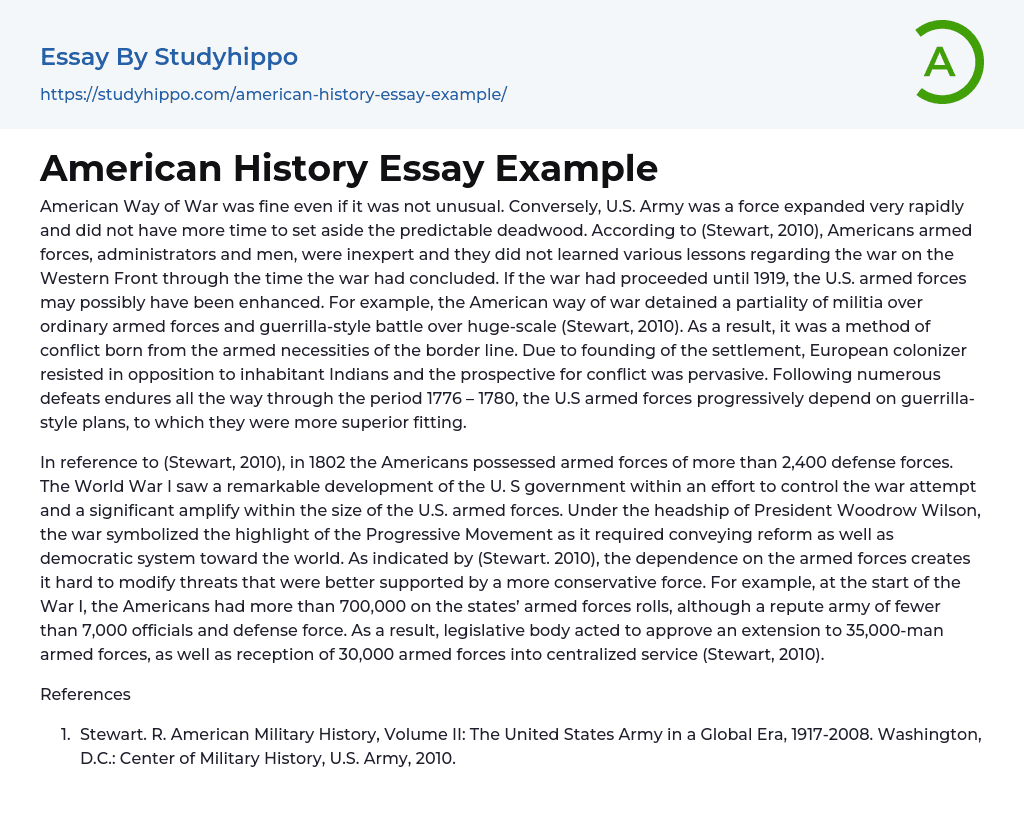American Way of War was fine even if it was not unusual. Conversely, U.S. Army was a force expanded very rapidly and did not have more time to set aside the predictable deadwood. According to (Stewart, 2010), Americans armed forces, administrators and men, were inexpert and they did not learned various lessons regarding the war on the Western Front through the time the war had concluded. If the war had proceeded until 1919, the U.S. armed forces may possibly have been enhanced. For example, the American way of war detained a partiality of militia over ordinary armed forces and guerrilla-style battle over huge-scale (Stewart, 2010). As a result, it was a method of conflict born from the armed necessities of the border line. Due to founding of the settlement, European colonizer resisted in opposition to inhabitant Indians and the pros
...pective for conflict was pervasive. Following numerous defeats endures all the way through the period 1776 – 1780, the U.S armed forces progressively depend on guerrilla-style plans, to which they were more superior fitting.
In reference to (Stewart, 2010), in 1802 the Americans possessed armed forces of more than 2,400 defense forces. The World War I saw a remarkable development of the U. S government within an effort to control the war attempt and a significant amplify within the size of the U.S. armed forces. Under the headship of President Woodrow Wilson, the war symbolized the highlight of the Progressive Movement as it required conveying reform as well as democratic system toward the world. As indicated by (Stewart. 2010), the dependence on the armed forces creates it hard to modify threats that were better supported by a
more conservative force. For example, at the start of the War I, the Americans had more than 700,000 on the states’ armed forces rolls, although a repute army of fewer than 7,000 officials and defense force. As a result, legislative body acted to approve an extension to 35,000-man armed forces, as well as reception of 30,000 armed forces into centralized service (Stewart, 2010).
References
- Stewart. R. American Military History, Volume II: The United States Army in a Global Era, 1917-2008. Washington, D.C.: Center of Military History, U.S. Army, 2010.
- Abolitionism essays
- Adam Smith essays
- American History essays
- American Revolution essays
- Ancient Egypt essays
- Articles Of Confederation essays
- Atlantic Slave Trade essays
- Aztec essays
- Benjamin Franklin essays
- Civil Rights Act of 1964 essays
- Civil Rights Movement essays
- Civil war essays
- Cleopatra essays
- French And Indian War essays
- Gettysburg essays
- Great Depression essays
- Hurricane Katrina essays
- Industrial Revolution essays
- Jamestown essays
- Manifest Destiny essays
- Mccarthyism essays
- Patrick Henry essays
- Pearl Harbor essays
- Pocahontas essays
- Prohibition essays
- Pyramids essays
- Salem Witch Trials essays
- Slavery essays
- The New Deal essays
- Thirteen Colonies essays
- Westward Expansion essays
- 1920S essays
- 1950S essays
- 1960S essays
- 19Th Century essays
- 20Th Century essays
- Ancient Greece essays
- Bravery essays
- British Empire essays
- Civilization essays
- Colonialism essays
- Declaration of Independence essays
- Evidence essays
- Genocide essays
- Gilded Age essays
- Historical Figures essays
- Historiography essays
- History of the United States essays
- Letter from Birmingham Jail essays
- Louisiana Purchase essays




